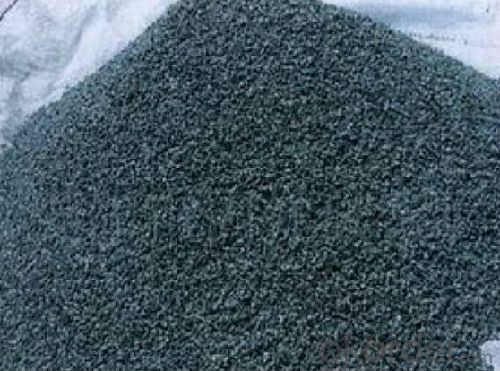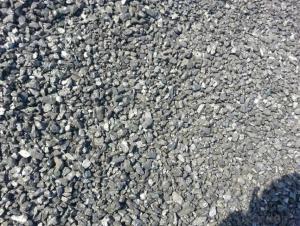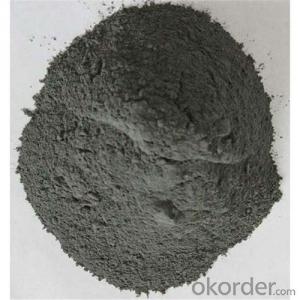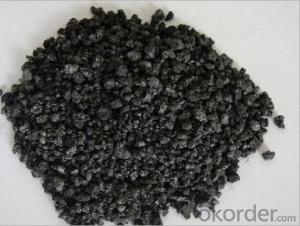Fuel Grade Petroleum Coke Calcined Coke Hot Sale
- Loading Port:
- Tianjin
- Payment Terms:
- TT or LC
- Min Order Qty:
- 20 m.t.
- Supply Capability:
- 1500 m.t./month
OKorder Service Pledge
OKorder Financial Service
You Might Also Like
Quick Details
Place of Origin: China (Mainland)
Application: carben additives
Dimensions: fix carben morethan98%,sulphur less5%
Chemical Composition: nature graphite powder
attribute: briquette grade
shape: <SPAN style="BORDER-BOTTOM: 0px; BORDER-LEFT: 0px; PADDING-BOTTOM: 0px; MARGIN: 0px; PADDING-LEFT: 0px; PADDING-RIGHT: 0px; FONT-FAMILY: inherit; WORD-WRAP: break-word; VERTICAL-ALIGN: baseline; BORDER-TOP: 0px; BORDER-RIGHT: 0px; PADDING-TOP: 0px" class=attr-value title=block/powder>block/powder
classify: carbon additives/petroleum coke
Packaging & Delivery
| Packaging Details: | 50kg/bag,25kg/bag or as customer requirement |
|---|---|
| Delivery Detail: | 20DAYS after payment |
Specifications
Fuel Grade Petroleum Coke Calcined Coke Hot Sale
Petroleum coke products can be divided into needle coke, sponge coke, projectile coke and coke breeze four kinds.
Calcined Petroleum Coke
F.C.: 98.5%MIN
ASH: 0.8% MAX
V.M.: 0.7%MAX
S:0.5%MAX
Moisture: 0.5%MAX
Structure
Fuel Grade Petroleum Coke Calcined Coke Hot Sale
Shape: granule
- Dimensions: 0-1mm, 1-5mm, 1-6mm, 2-8mm, etc
- Product Type: Carbon Additive
- C Content (%): 98-99.5% MIN
- Working Temperature: -
- S Content (%): 0.5%-0.7%MAX
- Ash Content (%): 0.7%MAX
- Volatile:0.8%MAX
- Moisture: 0.5% MAX
- ADVANTAGE: low ash & sulfur
- COLOR: Black
Feature
Fuel Grade Petroleum Coke Calcined Coke Hot Sale
Physics and chemistry performance:
Unit | Index | |||||
No.1 | No.2 | No.3 |
| |||
Density | g/cm3 | 2.04 | 2.00 | 2.00 | ||
sulphur content | %≤ | 0.5 | 1.0 | 2.5 | ||
volatility | %≤ | 0.5 | 0.5 | 0.5 | ||
ash content | %≤ | 0.5 | 0.5 | 0.5 | ||
moisture | %≤ | 0.3 | 0.5 | 0.5 | ||
charcoal | %≤ | 98.5 | 98.0 | 98.0 | ||
Image
Fuel Grade Petroleum Coke Calcined Coke Hot Sale


FAQ:
Fuel Grade Petroleum Coke Calcined Coke Hot Sale
How to classify calcined petroleum coke?
1) According to difference of sulfur content, can be divided into high sulfur coke (sulfur content more than 4%), sulphur in coke sulfur content (2% 4%) and low sulfur coke (sulfur content below 2%).
2) Petroleum coke products can be divided into needle coke, sponge coke, projectile coke and coke breeze four kinds:
3) Needle coke, has obvious needle-like structure and fiber texture, mainly used for steel-making in high power and ultra-high power graphite electrode. As a result of needle coke in sulfur content, ash content, volatile matter and true density and so on have strict quality requirements, so the production process of needle coke and raw materials have special requirements.
4) The sponge coke, high chemical reactivity, low content of impurities, mainly used in the aluminum industry and carbon industry.
5) Focal or spherical coke: the projectile shape is round, diameter 0.6-30 mm, usually from the production of high sulphur, high asphaltic residual oil, can only be used as industrial fuel power generation, cement etc.
6) Coke breeze: fluidized coking process, the fine particles (0.1- 0.4 mm) in diameter, high volatile, high expansion coefficient, cannot be directly used for electrode preparation and carbon industry.
Advantage:
Fuel Grade Petroleum Coke Calcined Coke Hot Sale
1. High quality and competitive price.
2. Timely delivery.
3. If any item you like. Please contact us.
Your sincere inquiries are typically answered within 24 hours.
- Q: Is carbon a conductor?
- Graphite is a conductor, diamond is notGraphite is a layer, C structure can guide electrons, but diamond is stable, C structure can not guide electronsTo see whether a substance is a conductor, the key is to see if it can lead to electrons - - this is an explanation in a middle school book
- Q: Power plant water treatment plant, there is a carbon removal device, the expert pointing out what the principle is it?
- The role of carbon dioxide removal in the process of ion exchange water treatment is to remove carbon dioxide from water, to reduce the load of anion exchange, to improve the economy of the water treatment system and the water quality of the effluent. The equipment uses blast degassing to remove the free carbon dioxide in the water. When the carbon dioxide content (Alkalinity) in the influent is greater than 50mg / 1, the carbon dioxide removal device is more economical and reasonable in the stage bed cleaning system. Behind the water treatment process in general on the hydrogen ion exchanger, as long as the choice of the right, the carbon remover, water residue of carbon dioxide is less than or equal to 5mg/L.
- Q: How is carbon used in the production of pharmaceuticals?
- Carbon is used in the production of pharmaceuticals through various processes such as carbonization, activation, and purification. It serves as a crucial component in the synthesis of drugs and plays a significant role in drug formulation, purification, and separation processes. Additionally, carbon-based materials are utilized as drug carriers and adsorbents to enhance drug delivery and optimize the efficiency of pharmaceutical manufacturing.
- Q: How do fossil fuels release carbon into the atmosphere?
- Combustion, a process in which fossil fuels like coal, oil, and natural gas are burned for energy, results in the release of carbon into the atmosphere. This carbon, which had been trapped underground for millions of years, is converted into carbon dioxide (CO2) gas. During combustion, the carbon and hydrogen atoms present in fossil fuels react with oxygen from the air, producing not only CO2 but also water vapor (H2O) and heat. The released CO2 is then emitted into the atmosphere, where it acts as a greenhouse gas. The burning of fossil fuels in various sectors such as transportation, electricity generation, and industrial processes plays a significant role in the escalating levels of atmospheric CO2. The continuous extraction and rapid burning of these fuels have led to a substantial increase in the concentration of CO2 in the Earth's atmosphere over the past century. This rise in atmospheric CO2 is a primary driver of climate change, as CO2 acts as a heat-trapping gas, contributing to the greenhouse effect. The greenhouse effect occurs when the Earth's atmosphere retains the heat radiated from the surface, resulting in a global temperature increase. Therefore, the release of carbon into the atmosphere from fossil fuels is a major concern due to its significant role in climate change and the subsequent environmental and societal impacts. To address these effects, there is a growing global effort to transition towards renewable and cleaner energy sources, reduce fossil fuel consumption, and implement sustainable practices.
- Q: What are the impacts of carbon emissions on natural disasters?
- Carbon emissions have a significant impact on natural disasters, exacerbating their intensity and frequency. One of the most prominent effects of carbon emissions is the contribution to global warming and climate change. As carbon dioxide and other greenhouse gases accumulate in the atmosphere, they trap heat and cause the Earth's temperature to rise. This rising temperature leads to various changes in weather patterns, which in turn increase the likelihood and severity of natural disasters. One of the most obvious impacts of carbon emissions on natural disasters is the intensification of hurricanes and tropical storms. Warmer ocean temperatures provide more energy for these storms, making them stronger and more destructive. Additionally, increased evaporation due to higher temperatures leads to heavier rainfall during storms, increasing the risk of flooding and landslides. Carbon emissions also contribute to the melting of glaciers and polar ice caps, leading to rising sea levels. This rise in sea levels increases the vulnerability of coastal areas to storm surges and flooding during hurricanes and typhoons. Low-lying regions and island nations are particularly at risk, as they face the possibility of losing their land to rising waters. Furthermore, carbon emissions play a role in the occurrence and severity of wildfires. As temperatures rise, vegetation becomes drier, creating ideal conditions for wildfires to ignite and spread quickly. These wildfires can devastate vast areas of land, destroying ecosystems, homes, and livelihoods. Another impact of carbon emissions on natural disasters is the disruption of weather patterns. Climate change is altering rainfall patterns, leading to longer and more severe droughts in some regions, while others experience more frequent and intense rainfall events. These changes in precipitation patterns can result in prolonged droughts, water scarcity, and increased risk of wildfires in some areas, while others face increased flooding and landslides. In conclusion, carbon emissions have a profound impact on natural disasters. They contribute to global warming and climate change, intensifying hurricanes, increasing the risk of flooding, raising sea levels, fueling wildfires, and disrupting weather patterns. It is crucial to reduce carbon emissions and transition to clean and sustainable energy sources to mitigate these impacts and protect our planet from the devastating effects of natural disasters.
- Q: How does carbon affect the formation of smog?
- Smog formation heavily relies on carbon's role, particularly through carbon monoxide (CO) and volatile organic compounds (VOCs). Burning fossil fuels, like in vehicles, power plants, or industrial processes, releases carbon into the atmosphere as CO and VOCs. These carbon emissions, especially in densely populated areas, contribute to smog formation. Smog consists of various air pollutants, primarily ground-level ozone, formed when nitrogen oxides (NOx) and VOCs react in sunlight's presence. Ground-level ozone formation starts with carbon monoxide. It reacts with nitrogen oxides and sunlight, resulting in ozone, a key smog component. VOCs, on the other hand, combine with nitrogen oxides in sunlight to create more ground-level ozone. Moreover, carbon particles, also called black carbon or soot, can contribute to smog formation. These particles absorb sunlight, heating the surrounding air and causing temperature inversions. These inversions trap pollutants near the ground, preventing dispersion and worsening smog formation. Controlling and preventing smog formation relies heavily on reducing carbon emissions. Implementing cleaner technologies, such as catalytic converters in vehicles and cleaner fuels, helps decrease CO and VOC release. Additionally, promoting renewable energy sources and reducing reliance on fossil fuels significantly reduces carbon emissions, thereby mitigating smog formation.
- Q: What is carbon offsetting in the travel industry?
- The travel industry utilizes carbon offsetting as a means of compensating for the carbon emissions generated during travel activities. This involves investing in projects that either decrease or eliminate an equivalent quantity of greenhouse gases from the atmosphere. Given that travel significantly contributes to global carbon emissions, carbon offsetting has emerged as a way for individuals and businesses to acknowledge their environmental impact and strive towards more sustainable practices. When individuals or companies choose to offset their travel emissions, they undertake a calculation of their trip's carbon footprint. This calculation takes into account factors such as distance traveled, mode of transport, and fuel consumption to determine the amount of carbon dioxide equivalent emitted during the journey. To counterbalance these emissions, they then allocate investments towards projects that reduce or eliminate the same amount of greenhouse gases from the atmosphere. These projects may include initiatives related to renewable energy, reforestation, or energy efficiency. The underlying idea of carbon offsetting is to achieve carbon neutrality, wherein the emissions produced are offset by an equal reduction or elimination of emissions elsewhere. By investing in offset projects, both travelers and travel companies can effectively mitigate their environmental impact and contribute to broader efforts in combating climate change. Carbon offsetting in the travel industry not only aids in reducing the carbon footprint of individual trips but also fosters the development of sustainable practices within the tourism sector. It grants travelers the opportunity to lessen their environmental impact by supporting projects that promote renewable energy, biodiversity conservation, or the betterment of local communities' livelihoods. However, it is crucial to ensure that carbon offset projects are credible and genuinely result in emission reductions. Verified standards and certifications, such as the Gold Standard or Verified Carbon Standard, play a significant role in guaranteeing the integrity and transparency of offset projects. Furthermore, it is essential to prioritize efforts in directly reducing emissions, such as utilizing more fuel-efficient transportation or opting for low-carbon alternatives, before solely relying on offsetting. In conclusion, carbon offsetting in the travel industry empowers individuals and businesses to take responsibility for their carbon emissions by investing in projects that decrease or eliminate greenhouse gases. It serves as a proactive approach towards minimizing the environmental impact of travel and promoting sustainable practices within the tourism sector.
- Q: How does carbon affect the preservation of historical artifacts?
- Carbon can negatively affect the preservation of historical artifacts by accelerating their deterioration through processes like oxidation, acidification, and microbial growth.
- Q: How does carbon dioxide affect the formation of smog?
- Carbon dioxide (CO2) does not directly contribute to the formation of smog. Smog is primarily formed by the interaction of sunlight with other pollutants such as nitrogen oxides (NOx) and volatile organic compounds (VOCs). These pollutants are emitted from various sources including vehicles, industrial processes, and power plants. However, while carbon dioxide does not directly participate in smog formation, it does play a significant role in contributing to climate change. CO2 is a greenhouse gas, meaning it traps heat in the Earth's atmosphere and contributes to the warming of the planet. As the Earth warms, it can lead to changes in weather patterns, resulting in more stagnant air conditions that can exacerbate smog formation. Additionally, the burning of fossil fuels, which releases carbon dioxide, is a major source of air pollutants like NOx and VOCs. So while CO2 itself may not directly contribute to smog formation, the activities that release CO2 can indirectly contribute to smog by releasing other pollutants that are involved in its formation. Therefore, the impact of carbon dioxide on smog formation is indirect, primarily through its contribution to climate change and the release of other pollutants. Reducing carbon dioxide emissions and transitioning to cleaner energy sources can help mitigate climate change and indirectly reduce the factors that contribute to smog formation.
- Q: Can carbon 14 identify the age of porcelain?
- Identification of porcelain by carbon 14 is not very accurate.The so-called carbon fourteen assay, radiocarbon dating, uses the carbon fourteen, which is widely found in nature, to measure the age of animals and plants. In prehistoric and ancient, the smaller the impact of human activities on the earth's environment, and carbon in nature fourteen proportions remain constant, animals and plants in the survival time, due to its in vivo The new supersedes the old. sake, carbon fourteen also remained constant; however, the once dead, in fourteen carbon will continue to decay, the half-life is 5730 years, in the sealed state and the outside world is obviously different, which is the principle of carbon fourteen dating. We must note that animals and plants belong to the organic matter. However, most cultural relics, such as porcelain, pottery and bronze, are inorganic. Therefore, the application of carbon fourteen dating in archaeology is very limited.
Send your message to us
Fuel Grade Petroleum Coke Calcined Coke Hot Sale
- Loading Port:
- Tianjin
- Payment Terms:
- TT or LC
- Min Order Qty:
- 20 m.t.
- Supply Capability:
- 1500 m.t./month
OKorder Service Pledge
OKorder Financial Service
Similar products
Hot products
Hot Searches
Related keywords



























